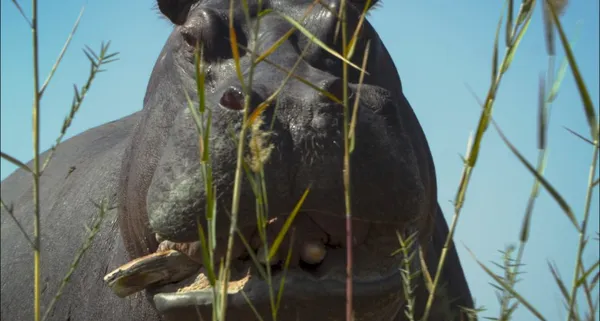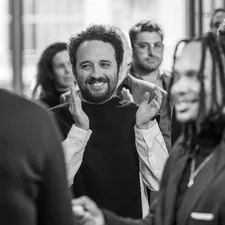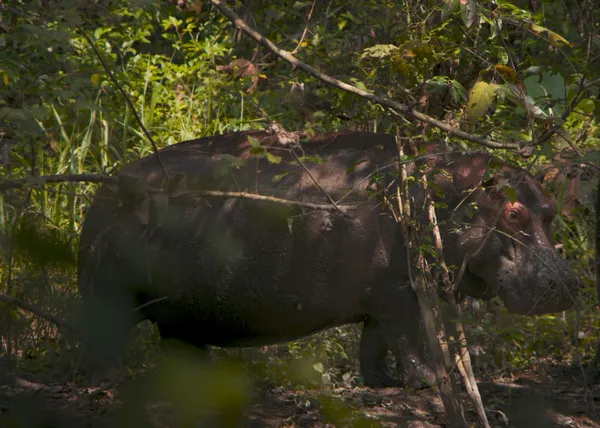 |
| Pepe. Carlo de Los Santos Arias on deciding on his voice: 'It was very simple and at the same time very difficult' Photo: Monte & Culebra |
One of the more experimental films in this year’s Berlin Film Festival competition, Nelson Carlo de Los Santos Arias’ Pepe sees a descendant of one of Pablo Escobar’s “cocaine hippos” ruminate in lugubrious tones about his own existence (and the end of it) while narrating a shaggy dog tale of the run-up to his death. Shot on a range of different film stock - and even including an animated Pepe in the style of Hanna Barbera - the film has a kinetic energy. Beyond Pepe himself, it also considers the impact of the hippos on the community that live near where Escobar’s farm was situated. Pepe won the Silver Bear for Best Director and we caught up with the director at the festival to talk about the challenges of shooting the film and some of the themes behind it.
One of the key elements of the film is the voice of Pepe himself, which is played by four actors in different languages. The filmmaker says that initially he was thinking of distorting the voice so that it sounded a bit like the Spanish version of the villain Mumra from children’s animation Thundercats but that he came to change his opinion.
He adds: “It was very simple and at the same time very difficult. When I say simple, it’s because it was inspired by a hippopotamus and the sound of hippopotamus and from this, how do I build this voice?
 |
| Nelson Carlo de Los Santos Arias at the Pepe premiere in Berlin: 'I love the tale within the tale' Photo: Courtesy of Berlinale |
Speaking about the multiple languages Pepe speaks, Carlo de Los Santos Arias notes that in Namibia he speaks Afrikaans and Mbukushu.
He adds: “Mbukushu is the language of the biggest tribe on the Okavango River. So what is it that Pepe should speak in the sense of building his identity? What is the identity that I should choose? Is it the European part? Or is it the African part? Or is it the Caribbean part? There’s no such thing as identity, it will be identities. Then [he speaks] Spanish with a Colombian accent, where actually Pepe was born.”
As Pepe goes along, there are stories within stories that develop, including that of local man Candelario (Jorge Puntillón García), whose own story about his encounter with the hippo is repeated but also disbelieved by his wife Betania (Sor María Ríos).
“I love the tale within the tale,” says Carlo de Los Santos Arias. “It is something that I have always been fascinated by. My favorite writer in the world is Roberto Bolaño [who wrote The Savage Detectives]. And I think he's a very important person in how I build narrative, but at the same time, I'm from the Caribbean, and we have a very good sense of humour.”
He says he thinks “narratively in small sketches and small moments”.
The film is a bracing mixture of techniques, with a hybridity that Carlo de Los Santos Arias says is something that has existed in his films since Santa Teresa And Other Stories in 2015. He notes that since then, there has been a trend towards hybrid films, particularly in the US but notes “you were able to see the part that was fiction”, which is something that he wanted to avoid.
 |
| Pepe in Colombia. Carlo de Los Santos Arias: 'This voice that you hear from these four actors has very few effects. It was very acting based' Photo: Monte & Culebra |
He adds: “So in order for me to actually embrace hybridity, I would have to do it in the modes of production. In the modes of production, you have the modes of creation. In that sense, I decided to do the writing and started to investigate what the sound landscape of this film would be. I can start working from a very intellectual perspective, but then it's a lot of intuition.”
The director says that this is also why he works with sound design. “I can not decide on a cut, if I don’t have a sound result,” he says. “My first cut is already the first cut of the sound design.”
He also says that he avoids watching films with similar subjects when he is making his own.
“We should not use cinema as the only source of our production of knowledge, so that's why normally when I'm making a film, I don't watch films that people say are related to my film. I never wanted to be like another person.”
He notes his experimental approach can make things tricky when it comes to getting films made.
“We made magic me and my producers, because something that is really fucked up for us is that we are contained by ‘national cinema’. Like in the way that we are financed. A European can get money in Europe and go everywhere to shoot. We cannot do that. Why do I have to see the world through and understand the world through a French filmmaker? I want to see a Bolivian filmmaker analysing the world and being able to travel.
“Because it was three countries it was quite complex. I can say that my shoots are fast but my development process is not and then my post-production moments are normal, it takes one year. The process of thinking, writing, investigating, this is where I take my time. By the time I get to the shooting and editing, I already did this film ten times in my head.”
























